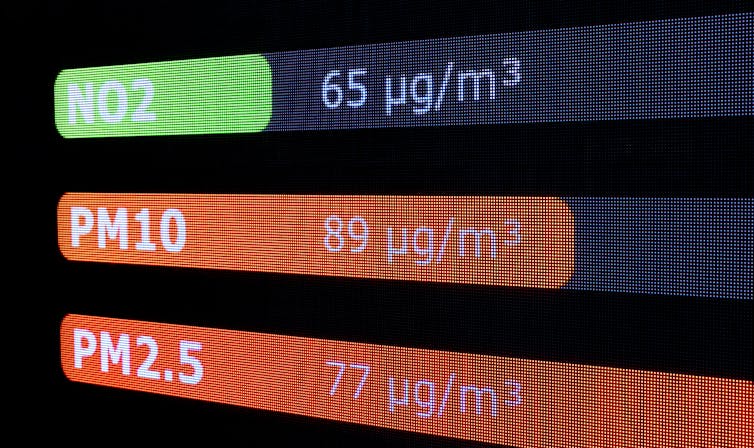According to the World Health Organization (WHO), about 31% of cardiovascular deaths could be avoided if the effects of environmental pollution were reduced.
Travel through history
As early as the time of Hippocrates, around 400 BC, people have known that environmental pollution poses health risks. He was the first to link various diseases to air quality.
According to Hippocrates, this connection was most evident in those Greek cities exposed to the westerly winds, where the voices of the inhabitants were hoarse and deep. In fact, today we know that certain diseases related to respiratory tract irritation, such as sinusitis, have high environmental risk factors.
Since the start of the Industrial Revolution more than 200 years ago, the amount of carbon dioxide (CO2) in the atmosphere has increased dramatically and is now more than 149% above pre-industrial levels. The last time in Earth’s history carbon dioxide levels rose that much was between 3 and 5 million years ago, when average temperatures were about 3 degrees Celsius higher and sea levels were about 15 meters higher.
Currently, especially due to the rise of the oil refining industry, its derivatives account for one-third of the emissions responsible for current environmental pollution.
The huge threat of particulate matter
In addition to carbon dioxide, other clinically important environmental pollutants are also increasing. This is the case with particulate matter (PM). particulates). These aerosols are heterogeneous mixtures of small solid particles, such as soot or smoke, often from industrial or vehicle combustion, traveling along with dust and pollen.
These particles are classified according to their size. The best known are PM10 (less than 10 μm in diameter) and PM2.5 (<2.5 μm). Particulate matter poses a threat to our health because it is small and can easily enter the bloodstream through our breathing and reach any part of the body.
((Link: external|||https://images.theconversation.com/files/550585/original/file-20230927-15-vynn9w.jpg?ixlib=rb-1.1.0&q=45&auto=format&w=1000&fit=clip| ||
 ))
))
tomeqs/Shutterstock
Once inside our tissues, it causes increased sympathetic nervous system activity, leading to increased blood pressure and increased heart and respiratory rates. As a result, inflammatory substances are released, creating a state of oxidative stress that is necessary to increase the risk of heart attack.
Currently, we know that high levels of these pollutants in the atmosphere can have irreversible negative effects on human health. Specifically, PM is thought to cause approximately 4 million deaths worldwide each year. To this end, the United Nations warns that we are facing “the most significant environmental health risk of our time.”
In Europe, we are not far behind. Back in 2018, the European Environment Agency (EEA) observed that 74% of the European population was exposed to particulate matter concentrations above recommended values. However, susceptibility to pollutant exposure varies depending on a person’s age or pre-existing health conditions, with younger people, older adults and people with certain medical conditions, such as heart and lung disease, being at greater risk.
Pollution and mortality, two phenomena that go hand in hand
Pollution is considered an important cardiovascular risk factor, after smoking, high blood pressure and poor lifestyle habits such as unhealthy diet and sedentary lifestyle. The World Health Organization estimates that in developed countries, this figure is alarming, as one in 10 cardiovascular deaths every day is related to environmental pollution.
In fact, current cardiovascular disease prevention guidelines already provide specific recommendations for avoiding high concentrations of environmental pollution.
In a recently published review, it became apparent that exposure to PM increases the risk of developing atrial fibrillation by up to 18%. It is the most common heart arrhythmia in the general population and causes irregular and abnormally fast contractions of cells in the atrium (heart muscle cells), increasing the risk of stroke and doubling the risk of death.
Measures to reduce the impact of pollution
The worsening prevalence and prognosis of different cardiovascular diseases necessitates certain environmental measures to reduce the impact of pollution on our health. Among them, reducing traffic in city centers can improve air quality.
We have seen the impact this can have during the covid-19 pandemic, where our movements have been restricted. In the first three weeks of Spain’s lockdown, pollution levels dropped by an astonishing approximately 50%, showing that it is possible to take measures and enjoy good air. We can do this through individual measures (using green transport) and collective measures.
And there’s no shortage of reasons: According to a recent study, 1.6 million deaths could be avoided by 2040 if the nine countries with the highest rates of pollutant production met the targets set out in the 2015 Paris Agreement.
Antonio J. Ruiz Alcaraz, Professor of Immunology at the University of Murcia and researcher at the IMIB Innate Immunity Group, University of Murcia; Darío Mandaglio Collados, Predoctoral Researcher, Clinical and Experimental Cardiology Group, University of Murcia; Francisco Marín Ortuño, Full Professor, Department of Cardiology, University Clinic Hospital Virgen de la Arrixaca, School of Medicine, University of Murcia, University of Murcia; José Miguel Rivera Caravaca, PhD Assistant Professor, Department of Nursing (School of Nursing, University of Murcia), University of Murcia and Raquel López Gálvez, Sara Borrell Postdoctoral Fellow in Clinical and Experimental Cardiology. Regional Health Training and Research Foundation of Murcia, University of Murcia
This article was originally published in The Conversation. Read the original article.
![]()

